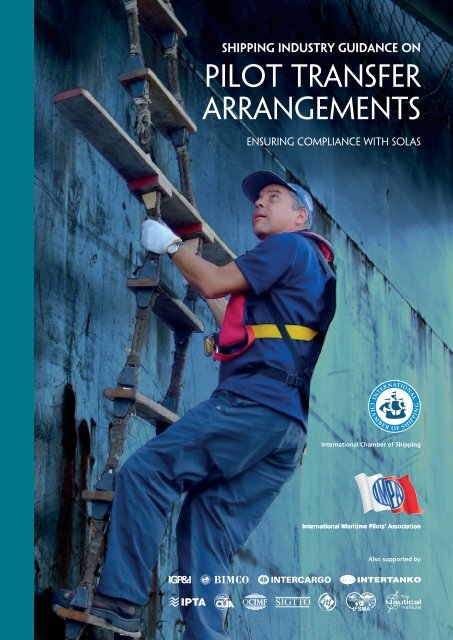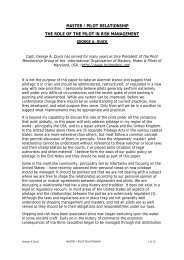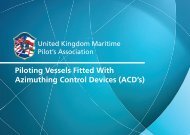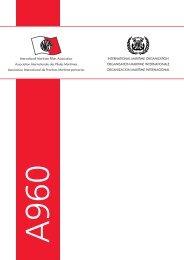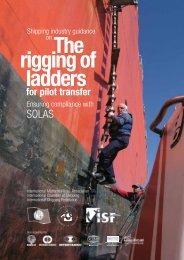Pilot Transfer Arrangements - International Maritime Pilots' Association
Pilot Transfer Arrangements - International Maritime Pilots' Association
Pilot Transfer Arrangements - International Maritime Pilots' Association
Create successful ePaper yourself
Turn your PDF publications into a flip-book with our unique Google optimized e-Paper software.
Shipping Industry Guidance on<strong>Pilot</strong> <strong>Transfer</strong><strong>Arrangements</strong>Ensuring Compliance with SOLAS<strong>International</strong> Chamber of Shipping<strong>International</strong> <strong>Maritime</strong> <strong>Pilot</strong>s’ <strong>Association</strong>Also supported by
Shipping Industry Guidance on<strong>Pilot</strong> <strong>Transfer</strong><strong>Arrangements</strong>Ensuring Compliance with SOLASThe following guidance has been produced by the <strong>International</strong> <strong>Maritime</strong> <strong>Pilot</strong>s’ <strong>Association</strong>(IMPA) in collaboration with the <strong>International</strong> Chamber of Shipping (ICS).General<strong>Pilot</strong>s come aboard ship to assist the crew during the mostcritical and potentially hazardous phases of a voyage.Qualified pilots possess particular local knowledge and havethe necessary ship-handling skills to assist the safe arrivaland departure of vessels.Normally, pilots board and disembark using a traditionalrope ladder from and to a pilot boat. However, this can be avery dangerous procedure if those involved do not adhere to<strong>International</strong> <strong>Maritime</strong> Organization (IMO) standards or failto practise acceptable seamanship skills.A number of pilots have died as a result of accidents whileboarding/disembarking from ships, and many more havebeen seriously injured.Furthermore, deficiencies with regard to boardingarrangements and unsafe rigging of pilot ladderscontinue to be detected during port state controlinspections, resulting in delays and financial penaltiesfor the ship operator.Nevertheless, pilot ladders remain the most safe andefficient way to board ships at sea and there is usually noalternative, except on occasions when a helicopter is used.The following guidance is intended to remind seafarers andshipping companies of the vital importance of adheringto the rules and established procedures concerning theprovision of safe boarding arrangements for pilots.A good arrangement
Ensuring Safe Rigging for <strong>Pilot</strong>sThe IMO Convention for Safety of Life at Sea(SOLAS Chapter V, Regulation 23) sets out theprincipal requirements for the rigging of pilot ladders.These provisions are set out in the diagram containedin this brochure. This diagram can be downloaded atwww.impahq.org (on home page, click ‘Downloads’).It is also reproduced in the ICS Bridge Procedures Guide.There is further detailed technical specification forpilot ladders in IMO Resolution A.1045(27). Shippingcompanies have a legal obligation to provide aconforming ladder and ship-borne fittings. If seafarersare uncertain about any of the requirements, they shouldalways ask their supervising officer for advice.The two major causes of accidents are defects in theladder treads or sideropes (see diagram) or a lack ofproper attachment of the ladder to the vessel.Seafarers should always check the condition of theladder before it is rigged and also ensure it is secure tothe ship. Whilst this is done, seafarers should always takecare of their own safety, wearing a life jacket (and alife-line if appropriate).Poor and incorrect securing methodManagement IssuesShipping companies should ensure that: on board have a full understanding of the requirements.IMPA is able to provide an advice document for newconstruction designs.On Board IssuesThe Master and officers should: ladders, ensuring that SOLAS requirements are met At all times during the rigging, use and de-rigging of anypilot transfer arrangements there should be no risk tothe ship’s crew. Crew members should not normally berequired to leave the protection of the ship’s safety railsor bulwarks. A life line or safety harness should be worn ifthere is any risk of falling.New SOLAS requirements from 1 July 2012Ships constructed after the 1 July 2012 mustcomply with the new equipment and arrangementrequirements of SOLAS Regulation V/23. Equipment andarrangements replaced on or after the 1 July 2012 onexisting ships, shall, so far is reasonable and practicable,comply with the requirements of this regulation.These requirements include the securing of anaccommodation ladder to the ship’s side, whenused in conjunction with the pilot ladder, and theprohibited use of mechanical pilot hoists.Summary<strong>Pilot</strong>s have the right to decline to board vessels offeringdefective ladders, which can result in serious delay.<strong>Pilot</strong>s are also entitled to report defects in boardingladders to port state control authorities, which couldlead to a full PSC inspection with the risk of delay andfinancial penalties.A pilot who has climbed a sound ladder, well rigged,and attended by an officer and a deck party will be inthe right frame of mind to give his best attention to thesafety of the vessel.
REQUIRED BOARDING ARRANGEMENTS FOR PILOTIn accordance with SOLAS Regulation V/23 & IMO Resolution A.1045(27)INTERNATIONAL MARITIME PILOTS’ ASSOCIATIONH.Q.S. “Wellington” Temple Stairs, Victoria Embankment, London WC2R 2PN Tel: +44 (0)20 7240 3973 Fax: +44 (0)20 7210 3518 Email: office@impahq.orgThis document and all IMO <strong>Pilot</strong>-related documents are available for download at: http://www.impahq.orgRIGGING FOR FREEBOARDSOF 9 METRES OR LESSHANDHOLDSTANCHIONSMin. Diam. 32mmMin.120cmAbove BulwarkHandholdsMin. 70cmMax. 80cmCOMBINATION ARRANGEMENTFOR SHIPS WITH AFREEBOARD OF MORETHAN 9 METRESWHEN NO SIDE DOOR AVAILABLENO!No shackles,knots or splicesNO!The steps must beequally spacedNO!The steps must behorizontal and chocksunder the steps must betightly securedAHandholdsMin. 70cmMax. 80cmPILOT LADDER WINCH REELPad eyeMinimumClearance220cmMAN-ROPES(without knots)Min. Diam. 28mmMax. Diam. 32mmIF REQUIREDBY THE PILOTSIDE ROPESMin. Diam. 18mmALL STEPSMust rest firmlyagainst ship’s sideSPREADERMin. 180cm LongMAXIMUM 9 STEPSBetween spreadersMin. 40cm31-35cmPILOT LADDERMust extendat least 2 metresabove lowerplatformLadder must befirmly attachedto ship’s side1.5 metres aboveaccommodationplatformA pilot ladderrequires a climbof not less than1.5 metres andno more than9 metresLowerplatformhorizontalThe lowerplatformshall be aminimumof 5 metresabove the seaMaximum45˚ slope2m2m0.5mACCOMMODATIONLADDERSecured toship’s sideShould lead aftRecommended9 metresfreeboard markSTERN BOWNO!Spreaders mustnot be lashedbetween stepsNO!Side ropes mustbe equally spacedNO!The steps shouldnot be painted,dirty or slipperyNO!Loops and trippinglines present atripping hazardand foul the<strong>Pilot</strong> LaunchHandhold stanchionsrigidly secured to deckResponsible Officerin contact with bridgeBMinimumClearance220cmMinimum91.5cmHandholdsMin. 70cmMax. 80cmNOOBSTRUCTIONSMin. 91.5cmMin. 91.5cmAll pilot ladder winch reels shouldhave a means of prevention frombeing accidentally operated.The brake and lock must beoperative on manually operatedwinches.Power winches must have anoperative safety device to lockthe winch in position.5th STEPFrom bottommust be a spreaderCSide opening6 METRESunobstructedship’s sideHeightRequired by <strong>Pilot</strong>Accommodationladder shouldbe secured toship’s sideMinimumClearance220cmHandholdsMin. 70cmMax. 80cmShip’s side doorsused for transfershould not openoutward(Using eyepad,magnetic orpneumaticsystem)Lifebuoy withself-igniting lightBulwark & <strong>Pilot</strong> laddersecured to deckstrong pointsMinimum91.5cm75cm75cm
DisclaimerThese Guidelines have been developed using the best information available, butthey are intended for guidance only, to be followed at the users’ own risk. Noresponsibility is accepted by any firm, corporation or organisation who or which hasbeen in any way concerned with the furnishing of data, the compilation, publicationor authorised translation, supply or sale of this guidance, for the accuracy of anyinformation or advice given herein, or any omission herefrom or consequenceswhatsoever resulting directly or indirectly from use of these guidelines or fromcompliance with or adoption of guidance contained therein.Shipping Industry Guidance on<strong>Pilot</strong> <strong>Transfer</strong> <strong>Arrangements</strong>Ensuring Compliance with SOLAS1st Edition 20082nd Edition 2012Published byMarisec Publications38 St Mary AxeLondon, EC3A 8BHTel +44 20 7090 1460Fax +44 20 7090 1484publications@marisec.orgwww.ics-shipping.orgAn electronic version of this leaflet is available at:www.ics-shipping.org/pilotladders and www.impahq.org/downloads.cfm© <strong>Maritime</strong> <strong>International</strong> Secretariat Services Limited 2012<strong>International</strong> Chamber of Shipping<strong>International</strong> <strong>Maritime</strong> <strong>Pilot</strong>s’ <strong>Association</strong>Also supported by


